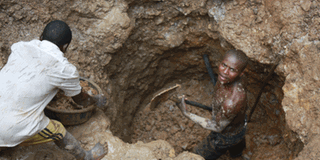Govt sets ground rules for artisan, small scale miners

Miners from Nyakaziba village. In 2006, gold exports brought in $122m, yet, the minieral remains locked in a largely unmonitored sector dominated by small-scale players. Photo by Isaac Imaka.
What you need to know:
- An artisanal miner is one who doesn’t have the ability to afford high-end technologies to mine, while a small-scale miner is one who has access to a reasonable amount of capital from, say, Shs50m and above.
The government has moved to regulate the operations of more than one million Ugandans who directly or indirectly benefit from Artisanal and Small Scale Mining (ASM).
An artisanal miner is one who doesn’t have the ability to afford high-end technologies to mine, while a small-scale miner is one who has access to a reasonable amount of capital from, say, Shs50m and above.
“Most of the artisanal miners neglect the fact that they have access to mining without having the proper technologies and these have health effects in the near future,” Ms Phiona Nyamutoro, the junior Minerals Development minister, said during a consultative meeting on the regulations of the ASM sector in Uganda in Busia District.
She added: “The exploitation by the bigger investors and other big players in the mining sector should also be addressed in ensuring they have good pay for the little that they are able to mine and are legally allowed to trade.”
Ms Nyamutoro said the government is going to reach all the central places that have a significant number of artisanal miners so that “this is inclusive enough” to ensure all their issues are captured. This is in a bid to help them have a regulation in place that is appreciative of the people.
“In the past, there was little appreciation of the contribution ASM had to the mining sector and there was a very big misunderstanding of whether they legally should be recognised as miners, or they were just disruptive to the mining sector,” she said.
“But overtime, we got to appreciate that they are Ugandans and are also stakeholders in the mining sector because the resources belong to the country and it is very important that even to the smallest level, they should be supported by the government,” she added.
Some of the changes, she says, have introduced artisan mining licenses and small scale mining licenses, whose process of acquiring she described as “seamless”.
“For the artisanal miners, once they organise themselves in a group, all they have to do is to apply, pay the required registration fees of Shs1m and are supported by the ministry,” said Ms Nyamutoro, adding, “So far, we have so many applications from different groups and I think they are very appreciative of this particular licence because it has made work very easy for them and they are also formally recognised in their capacities.”
Ms Irene Bateebe, the permanent secretary in the Energy ministry, said Uganda’s mining industry is dominated by more than one million Ugandans who directly or indirectly benefit from ASM operations.
Minerals
She said the minerals mined by ASMs and widely distributed throughout the country include gold, tin, wolfram (tungsten), tantalite columbite-tantalite, iron ore, gemstones, limestone, Marble, Kaolin, diatomite pozzolana, and salt.
According to her, the ministry has made tremendous progress in improving the existing ASM management. It has done this by granting mineral licenses to ASMs; processing more than 100 location licenses—up from five in 2003; and undertaking biometric registration of ASMs, which has seen 7,455 miners biometrically registered, of which 2,070 are from the eastern region.
Mr Jonny Sasirwe, a miner who has reportedly been in the sector for more than 35 years, said the new regulation isn’t in good faith.
“For instance, the old regulation gave us a location licence of 16 hectares, on which we were to invest Shs10m, but now, the same licence being given to artisanal miners has a limitation in capacity,” Mr Sasirwe said.
According to Mr Sasirwe, a person who had a licence of 16 hectares and had a chance to partner with an investor, is now being given a maximum of 10 square metres and barred from bringing in a foreign co-investor. Mr Sasirwe, who says he has another mine in Mubende, added that getting a mandatory Environmental Impact Assessment (EIA) certificate has reportedly taken him over three years and cost him more than Shs100m.
Mr Charles Buyinza, another gold miner for the past 15 years and chief executive director of Kakoba Productions Ltd, said transforming from working without a licence to working with one may not be easy. He said whereas the ministry is trying to organise and regulate them, they first want the licenses issued and other requirements like the EIA to follow later.
“Private environmental specialists ask for between Shs20m and Shs30m for them to process or to advise you. Mining is a very expensive venture and has no static budget, but we lack access to money. You may have Shs100m but use it in a few days or weeks yet you need equipment,” he said.
The government is working with implementing agencies, including Planet Gold, whose environment officer, Mr Dean Ocama, said the project is to reduce mercury usage among ASM.
“Mercury is one of the toxic chemicals globally recognised by the World Health Organisation, and in Uganda, they are adopting a four-pillar intervention model in 11 mining sites across seven districts, including Busia, Namayingo, Moroto, Amudat, Kasanda, Kisoro and Buhweju,” Mr Ocama said.





